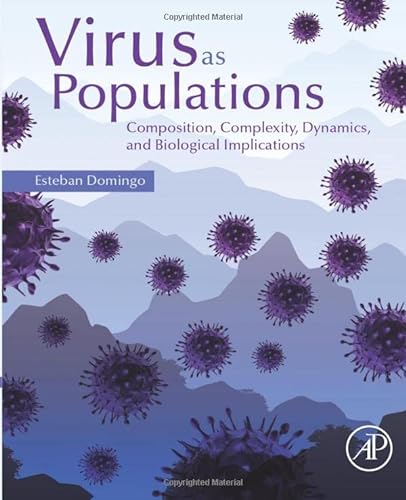
Synopsis
Virus as Populations: Composition, Complexity, Dynamics, and Biological Implications explains fundamental concepts that arise from regarding viruses as complex populations when replicating in infected hosts. Fundamental phenomena in virus behavior, such as adaptation to changing environments, capacity to produce disease, probability to be transmitted or response to treatment, depend on virus population numbers and in the variations of such population numbers. Concepts such as quasispecies dynamics, mutations rates, viral fitness, the effect of bottleneck events, population numbers in virus transmission and disease emergence, new antiviral strategies such as lethal mutagenesis, and extensions of population heterogeneity to nonviral systems are included. These main concepts of the book are framed in recent observations on general virus diversity derived from metagenomic studies, and current views on the origin of viruses and the role of viruses in the evolution of the biosphere.
"synopsis" may belong to another edition of this title.
About the Author
Esteban Domingo studied chemistry and biochemistry at the University of Barcelona, Spain and spent postdoctoral stays at the University of California, Irvine and the University of Zürich. His main interests are the quasispecies structure of RNA viruses and the development of new antiviral strategies. He is presently Professor of Research of the Spanish Research Council (CSIC) at Centro de Biología Molecular "Servero Ochoa" in Madrid.
From the Back Cover
Virus as Populations: Composition, Complexity, Dynamics, and Biological Implications explains fundamental concepts that arise from regarding viruses as complex populations when replicating in infected hosts. Fundamental phenomena in virus behavior, such as adaptation to changing environments, capacity to produce disease, probability to be transmitted or response to treatment, depend on virus population numbers and in the variations of such population numbers. Concepts such as quasispecies dynamics, mutations rates, viral fitness, the effect of bottleneck events, population numbers in virus transmission and disease emergence, new antiviral strategies such as lethal mutagenesis, and extensions of population heterogeneity to nonviral systems are included. These main concepts of the book are framed in recent observations on general virus diversity derived from metagenomic studies, and current views on the origin of viruses and the role of viruses in the evolution of the biosphere.
"About this title" may belong to another edition of this title.
Search results for Virus as Populations: Composition, Complexity, Dynamics,...
Virus as Populations: Composition, Complexity, Dynamics, and Biological Implications
Print on DemandSeller: Brook Bookstore On Demand, Napoli, NA, Italy
Condition: new. Questo è un articolo print on demand. Seller Inventory # 9e8195faa79eea337d6f4c9dde366c0c
Virus as Populations: Composition, Complexity, Dynamics, and Biological Implications
Seller: Chiron Media, Wallingford, United Kingdom
Paperback. Condition: New. Seller Inventory # 6666-ELS-9780128008379
Buy New
Quantity: Over 20 available
Virus As Populations: Composition, Complexity, Dynamics, and Biological Implications
Seller: Revaluation Books, Exeter, United Kingdom
Paperback. Condition: Brand New. 360 pages. 9.25x7.50x0.75 inches. In Stock. Seller Inventory # __0128008377
Virus as Populations
Seller: BuchWeltWeit Ludwig Meier e.K., Bergisch Gladbach, Germany
Taschenbuch. Condition: Neu. Neuware -Virus as Populations: Composition, Complexity, Dynamics, and Biological Implications explains fundamental concepts that arise from regarding viruses as complex populations when replicating in infected hosts. Fundamental phenomena in virus behavior, such as adaptation to changing environments, capacity to produce disease, probability to be transmitted or response to treatment, depend on virus population numbers and in the variations of such population numbers. Concepts such as quasispecies dynamics, mutations rates, viral fitness, the effect of bottleneck events, population numbers in virus transmission and disease emergence, new antiviral strategies such as lethal mutagenesis, and extensions of population heterogeneity to nonviral systems are included. These main concepts of the book are framed in recent observations on general virus diversity derived from metagenomic studies, and current views on the origin of viruses and the role of viruses in the evolution of the biosphere. 428 pp. Englisch. Seller Inventory # 9780128008379
Virus as Populations: Composition, Complexity, Dynamics, and Biological Implications
Seller: THE SAINT BOOKSTORE, Southport, United Kingdom
Paperback / softback. Condition: New. New copy - Usually dispatched within 4 working days. 1051. Seller Inventory # B9780128008379
Buy New
Quantity: Over 20 available
Virus as Populations
Print on DemandSeller: moluna, Greven, Germany
Condition: New. Dieser Artikel ist ein Print on Demand Artikel und wird nach Ihrer Bestellung fuer Sie gedruckt. Virus as Populations: Composition, Complexity, Dynamics, and Biological Implications explains fundamental concepts that arise from regarding viruses as complex populations when replicating in infected hosts. Fundamental phenomena in virus behavior, s. Seller Inventory # 35208991
Virus as Populations | Composition, Complexity, Dynamics, and Biological Implications
Seller: preigu, Osnabrück, Germany
Taschenbuch. Condition: Neu. Virus as Populations | Composition, Complexity, Dynamics, and Biological Implications | Esteban Domingo | Taschenbuch | Englisch | 2015 | Elsevier Science | EAN 9780128008379 | Verantwortliche Person für die EU: Libri GmbH, Europaallee 1, 36244 Bad Hersfeld, gpsr[at]libri[dot]de | Anbieter: preigu. Seller Inventory # 104592348
Virus as Populations : Composition, Complexity, Dynamics, and Biological Implications
Print on DemandSeller: AHA-BUCH GmbH, Einbeck, Germany
Taschenbuch. Condition: Neu. nach der Bestellung gedruckt Neuware - Printed after ordering - Virus as Populations: Composition, Complexity, Dynamics, and Biological Implications explains fundamental concepts that arise from regarding viruses as complex populations when replicating in infected hosts. Fundamental phenomena in virus behavior, such as adaptation to changing environments, capacity to produce disease, probability to be transmitted or response to treatment, depend on virus population numbers and in the variations of such population numbers. Concepts such as quasispecies dynamics, mutations rates, viral fitness, the effect of bottleneck events, population numbers in virus transmission and disease emergence, new antiviral strategies such as lethal mutagenesis, and extensions of population heterogeneity to nonviral systems are included. These main concepts of the book are framed in recent observations on general virus diversity derived from metagenomic studies, and current views on the origin of viruses and the role of viruses in the evolution of the biosphere. Seller Inventory # 9780128008379
